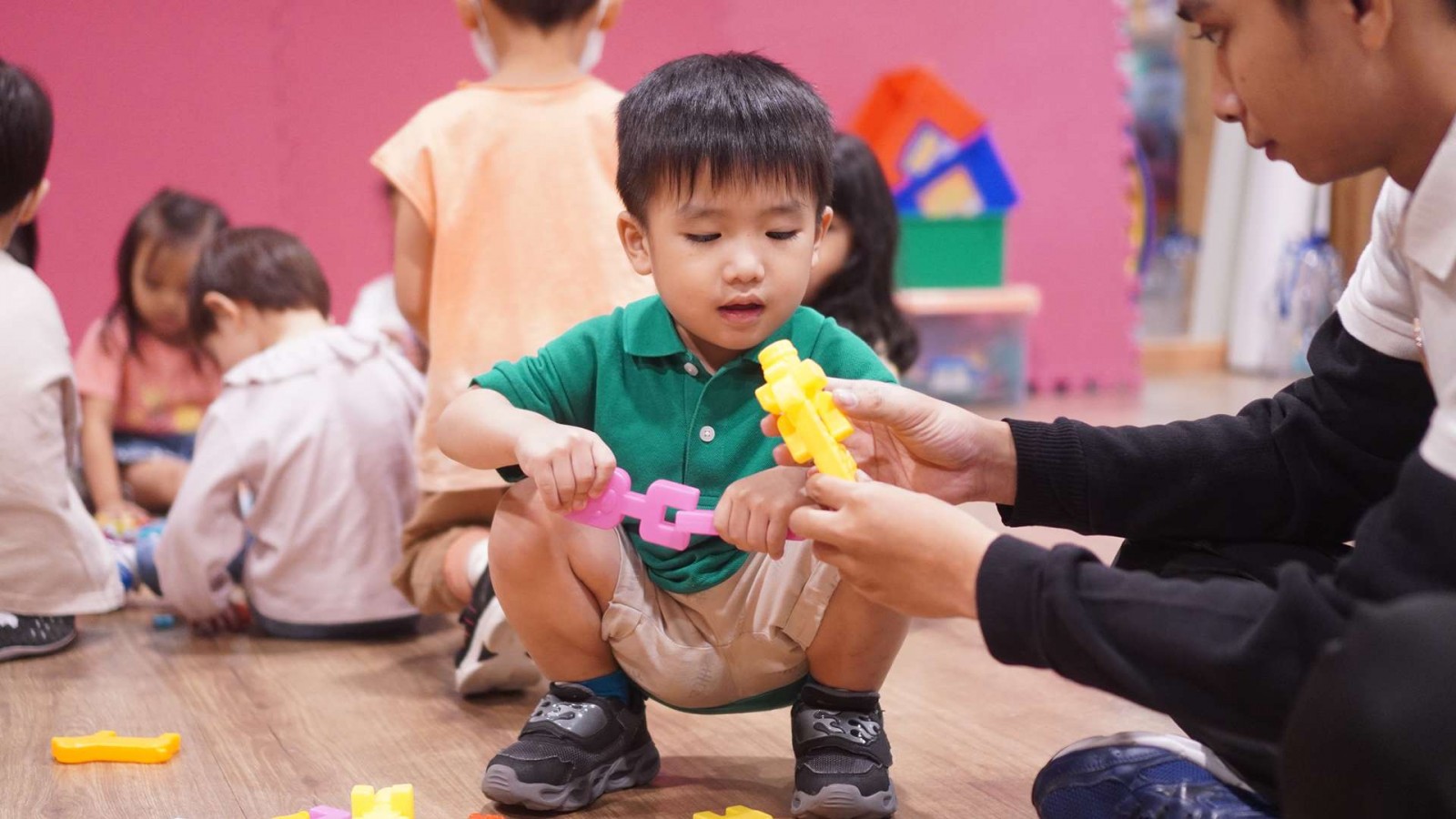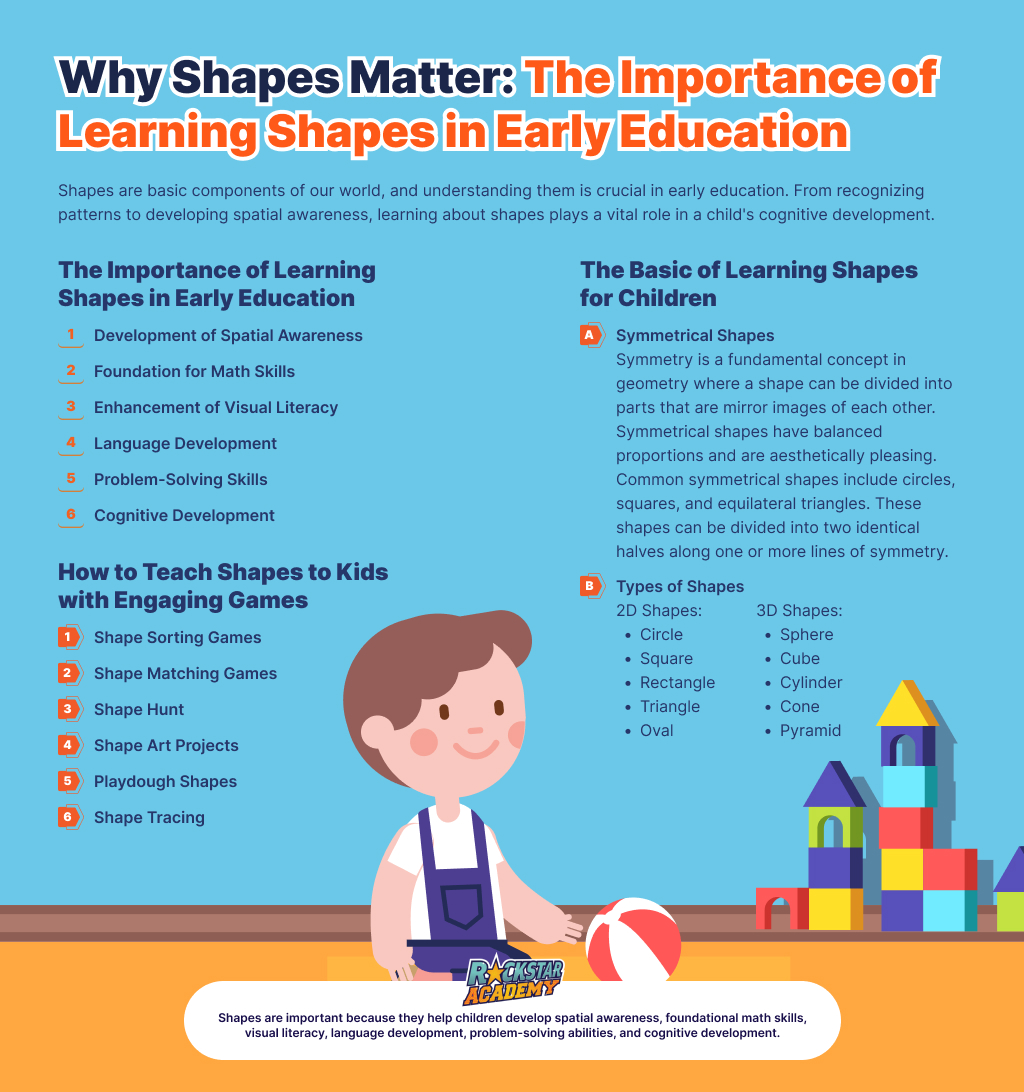Why Shapes Matter: The Importance of Learning Shapes in Early Education

Shapes are basic components of our world, and understanding them is crucial in early education. From recognizing patterns to developing spatial awareness, learning about shapes plays a vital role in a child's cognitive development.
This article delves into what shapes are, the different types of shapes, their importance in early education, and effective methods to teach them to young learners.
The Basic of Learning Shapes for Children
Shapes are the forms of things we see around us. They can be circles, squares, triangles, and more. Shapes can be flat like a piece of paper, or they can be solid like a ball or a box. Learning about shapes helps us understand how different things look and fit together in our world.
Here are several things you should know as parent if you want to teach your children about shapes:
A. Symmetrical Shapes
Symmetry is a fundamental concept in geometry where a shape can be divided into parts that are mirror images of each other. Symmetrical shapes have balanced proportions and are aesthetically pleasing.
Common symmetrical shapes include circles, squares, and equilateral triangles. These shapes can be divided into two identical halves along one or more lines of symmetry.
B. Types of Shapes
2D Shapes
Two-dimensional shapes have length and width but no depth. They are flat and can be drawn on a plane. Examples of 2D shapes include:
- Circle: A round shape with all points equidistant from the center.
- Square: A shape with four equal sides and four right angles.
- Rectangle: A shape with opposite sides equal and four right angles.
- Triangle: A shape with three sides and three angles.
- Oval: A shape resembling a stretched circle.
3D Shapes
Three-dimensional shapes have length, width, and depth. They occupy space and have volume. Examples of 3D shapes include:
- Sphere: A perfectly round 3D shape where all points are equidistant from the center.
- Cube: A shape with six equal square faces.
- Cylinder: A shape with two parallel circular bases connected by a curved surface.
- Cone: A shape with a circular base and a pointed top.
- Pyramid: A shape with a polygonal base and triangular faces that converge to a point.
The Importance of Learning Shapes in Early Education
Learning shapes is crucial in early education as it lays the foundation for various cognitive and developmental skills in children. It also introduces fundamental math concepts, forming the basis for geometry and more advanced mathematical learning.
Learning about shapes is essential in early education for several reasons:
1. Development of Spatial Awareness
Understanding shapes helps children develop spatial awareness, which is the ability to understand and interact with the space around them. Recognizing and manipulating shapes improves their ability to comprehend and navigate their environment.
2. Foundation for Math Skills
Shapes are the building blocks of geometry which is a crucial aspect of mathematics. Early familiarity with shapes lays the groundwork for more advanced math concepts such as area, volume, and spatial reasoning.
3. Enhancement of Visual Literacy
Visual literacy is the ability to interpret and make meaning from information presented in the form of images. Learning shapes enhances visual literacy and allows children to recognize patterns, symbols, and structures in their environment.
4. Language Development
Describing shapes and their properties encourages the development of language skills. Children learn new vocabulary and improve their ability to articulate their thoughts.
5. Problem-Solving Skills
Manipulating shapes and solving puzzles that involve shapes enhance problem-solving skills. Children learn to think critically and creatively to achieve desired outcomes.
6. Cognitive Development
Identifying and categorizing shapes stimulate cognitive development. Children will learn to observe, compare, and differentiate between various shapes, which enhances their analytical abilities.
How to Teach Shapes to Kids with Engaging Games
Teaching shapes to kids can be a fun and engaging process when using games and activities that capture their interest. Here are some effective and enjoyable ways to teach shapes to children:
1. Shape Sorting Games
This activity provides children with a variety of objects in different shapes and asks them to sort these objects into categories based on their shapes.
It enhances shape recognition and categorization skills. It also improves fine motor skills as children handle and sort the objects.
Example: Use everyday items like blocks, buttons, and toys. Have separate bins or trays labeled with different shapes (circle, square, triangle, etc.) and let the children place the objects in the correct bin.
2. Shape Matching Games
Next activity you can try is by creating cards with different shapes and having children match the cards with objects of the same shape.This game reinforces shape recognition and improves memory skills.
Example: Draw or print cards with various shapes. Lay out the cards and provide objects (like shape toys or cut-outs) that match the cards. Encourage children to place each object on the matching card.
3. Shape Hunt
You can also teach your children learning shapes by organizing a shape hunt where children search for objects in their environment that match specific shapes.
This activity encourages observation and reinforces the concept of shapes in real-world contexts.
Example: Give children a list of shapes to find (circle, square, triangle, etc.). They can look around the house, classroom, or playground and point out or collect items that match the shapes on their list.
4. Shape Art Projects
Next is by incorporating shapes into art projects where children use shape stamps, cut out shapes from colored paper, or draw shapes to create pictures.
This combines creativity with shape recognition and helps in developing fine motor skills.
Example: Provide colored paper, scissors, glue, and markers. Children can cut out shapes and glue them onto a larger paper to make a picture, like a house with a square base, a triangular roof, and circular windows.
5. Playdough Shapes
Using playdough to form different shapes reinforces shape understanding through hands-on play and improves fine motor skills.
Example: Provide playdough and shape cutters (or use hands to mold shapes). Ask children to create various shapes like circles, squares, and triangles with the playdough.
6. Shape Tracing
Shape tracing is an effective method for helping children learn and recognize shapes. You can provide worksheets or create your own with different shapes for children to trace.
Tracing shapes helps in developing fine motor skills and reinforces the ability to recognize and draw shapes.
Example: Print out or draw shapes on paper. Give children pencils, crayons, or markers to trace over the shapes, helping them learn to draw each shape accurately.
Learning Shapes Is Important!
Learning about shapes is a crucial aspect of early childhood education that impacts various areas of development. If your children need help in learning shapes, one way to support them is by enrolling them in an early childhood program at Rockstar Academy.
At Rockstar Academy, your child can experience a comprehensive preschool and kindergarten curriculum, participate in various physical activities, and join events and competitions designed for different ages, skill levels, and interests. T
hese experiences provide vital opportunities for children to develop academically, socially, and emotionally, while also excelling in mathematics for kindergarten.
Additionally, Rockstar Academy offers a free trial class for anyone interested in exploring our programs. If you are interested, make sure to contact Rockstar Academy today.

FAQ
Why are shapes important in early childhood education?
Shapes are important because they help children develop spatial awareness, foundational math skills, visual literacy, language development, problem-solving abilities, and cognitive development.
At what age should children start learning about shapes?
Children can start learning about shapes as early as 2 years old. Simple shape recognition can begin at this age, with more complex understanding developing as they grow older.
How can I make learning shapes fun for my child?
Incorporate games, songs, and hands-on activities into learning sessions. Use everyday objects to teach shapes and encourage your child to find shapes in their environment.
What are some everyday objects that can help teach shapes?
Common household items like plates (circles), books (rectangles), dice (cubes), and cans (cylinders) can be used to teach shapes. Pointing out these shapes in everyday life helps reinforce learning.



